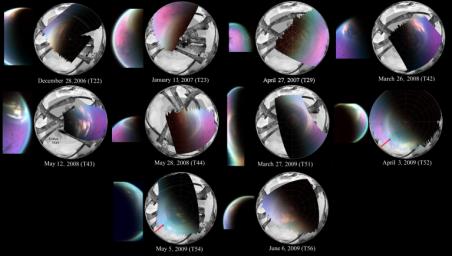
|
Changes in Titan’s North Polar Cloud
- Click the image above for a larger view
- Full-Res JPEG (2935 x 1661) (451.5 kB)
- Full-Res TIFF (2935 x 1661) (14.6 MB)
Caption:
This series of images obtained by NASA's Cassini spacecraft shows several views of the north polar cloud covering Saturn's moon Titan. The false-color images were obtained by Cassini's visual and infrared mapping spectrometer (VIMS). They can be seen on the left of each pair of images, with that same image re-projected onto a globe of Titan on the right. The global image shows Titan's north pole at the center. Other parts of the Titan globe are filled in using data from Cassini's imaging cameras and radar instrument.
The VIMS images cover 2006 to 2009, when Titan was transitioning from northern winter to northern spring. In 2006, the north polar cloud appeared dense and opaque. But in spectrometer images obtained around the 2009 equinox, when the sun was directly over Saturn and Titan's equators and northern winter was turning into spring, the cloud appeared much thinner and patchier. It allowed scientists to see the underlying northern lakes and seas on the surface, including Kraken Mare (at the end of the red arrows). The northern seas and lakes, made of liquid hydrocarbons, look like dark jigsaw puzzle pieces in the false-color images.
Scientists colorized the VIMS image by assigning red, green and blue to the parts of the infrared spectrum around 5 micrometers, 2.8 micrometers and 2.03 micrometers, respectively. The images create a kind of time-lapse series from Dec. 28, 2006 to June 6, 2009, from the 23rd, 24th, 30th, 43rd, 44th, 45th, 52nd, 53rd, 55th and 57th time Cassini flew by Titan. (Planning changes early in the orbital tour meant that even though a Titan flyby might be called "T22," it was actually the 23rd flyby of Titan.)
For a view of just the VIMS images, see PIA15230 .
Background Info:
The Cassini-Huygens mission is a cooperative project of NASA, the European Space Agency and the Italian Space Agency. NASA's Jet Propulsion Laboratory, a division of the California Institute of Technology in Pasadena, manages the mission for NASA's Science Mission Directorate, Washington, DC. The Cassini orbiter was designed, developed and assembled at JPL. The visual and infrared mapping spectrometer was built by JPL, with a major contribution by the Italian Space Agency (ASI). The visual and infrared mapping spectrometer science team is based at the University of Arizona, Tucson. The imaging operations center is based at the Space Science Institute in Boulder, Colo. The radar instrument was built by JPL and the ASI, working with team members from the United States and several European countries.
For more information about the Cassini-Huygens mission, visit http://saturn.jpl.nasa.gov/ .
Cataloging Keywords:
| Name | Value | Additional Values |
|---|---|---|
| Target | Titan | Saturn |
| System | Saturn | |
| Target Type | Satellite | Planet |
| Mission | Cassini-Huygens | |
| Instrument Host | Cassini Orbiter | |
| Host Type | Orbiter | |
| Instrument | Visual and Infrared Mapping Spectrometer (VIMS) | |
| Detector | ||
| Extra Keywords | Color, Infrared, Radar, Visual | |
| Acquisition Date | ||
| Release Date | 2012-02-23 | |
| Date in Caption | 2006-12-28 | 2009-06-06 |
| Image Credit | NASA/JPL-Caltech/University of Arizona/CNRS/LPGNantes | |
| Source | photojournal.jpl.nasa.gov/catalog/PIA15231 | |
| Identifier | PIA15231 | |
